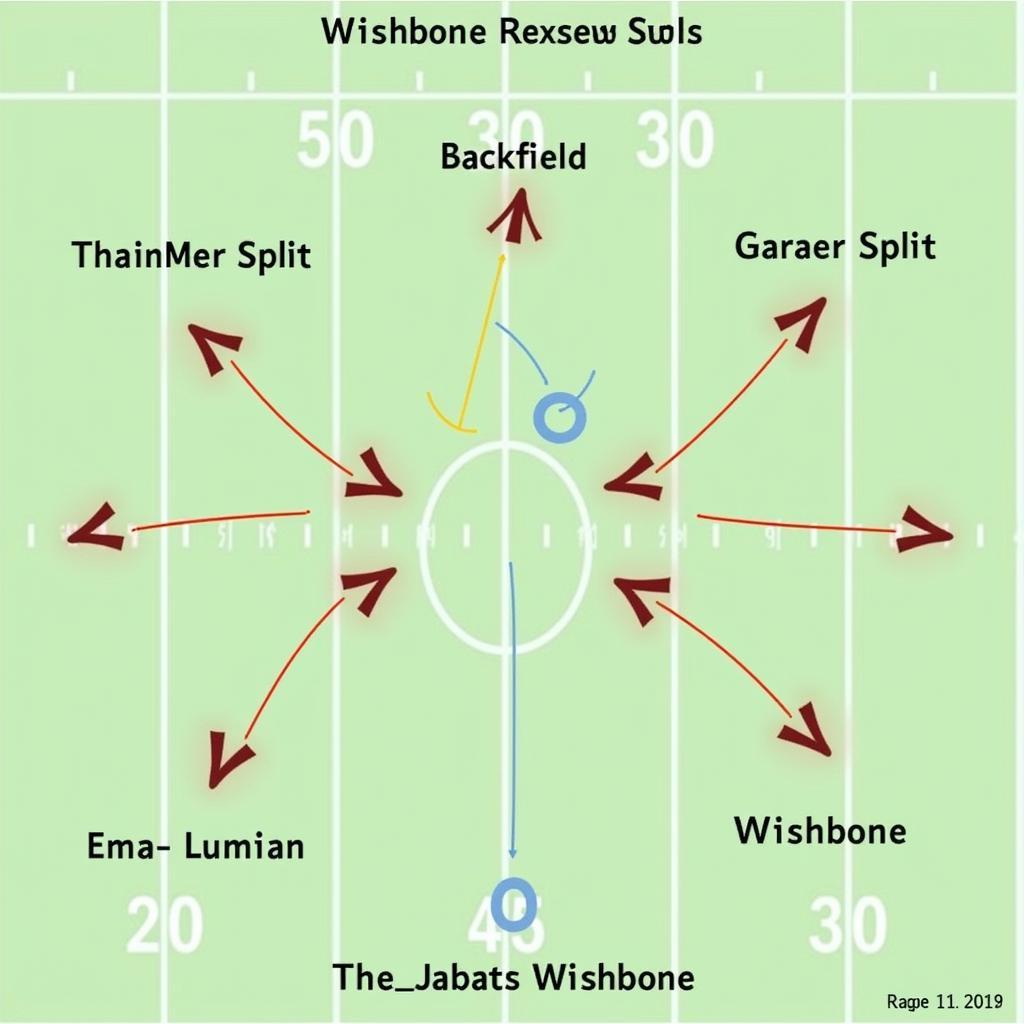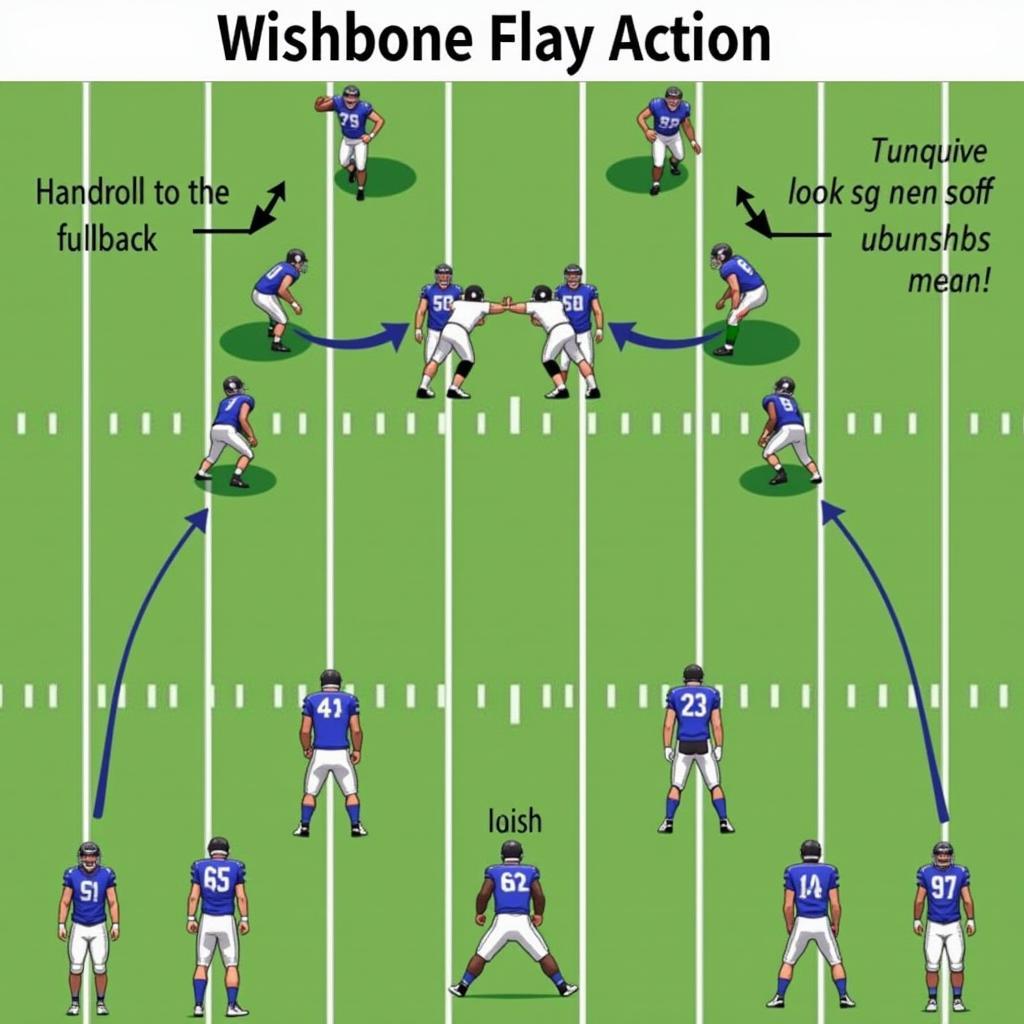The Wishbone Playbook, a relic of a bygone era in football, still holds a certain fascination for coaches and fans alike. This comprehensive guide will delve into the intricacies of the wishbone offense, exploring its history, key plays, advantages, disadvantages, and its place in the modern game. We’ll examine how this unique formation can be adapted and utilized even in today’s evolving football landscape.
Understanding the Basics of the Wishbone Playbook
The wishbone formation gets its name from its distinctive backfield alignment, resembling a wishbone. With three running backs positioned behind the quarterback, this formation presents a triple-option threat that can keep defenses guessing. The fullback lines up directly behind the quarterback, while the two halfbacks are slightly offset on either side, forming the “arms” of the wishbone. This positioning allows for quick handoffs, misdirection plays, and a powerful running game. This formation has deep roots in the history of football, reaching peak popularity in the 1970s and 80s. Want to find other playbooks? Check out the college football 25 playbook finder.
Key Plays in the Wishbone Formation
Several key plays define the wishbone playbook. The triple option, perhaps the most iconic wishbone play, gives the quarterback three choices: hand off to the fullback, pitch to a trailing halfback, or keep the ball himself. The success of the triple option relies heavily on reading the defense and making quick decisions. Other important plays include the counter option, where the fullback receives the initial handoff but then gives the ball to a halfback running in the opposite direction, and the dive play, a straight handoff to the fullback designed to exploit gaps in the defensive line. A good understanding of wishbone formation plays is essential for successfully implementing this offense.
Advantages and Disadvantages of the Wishbone Playbook
The wishbone offense offers several advantages, most notably its ability to control the clock and dominate time of possession. The emphasis on running the ball can wear down opposing defenses, opening up opportunities for big plays later in the game. The triple option’s inherent deception can also confuse defenses and lead to breakdowns in assignments. However, the wishbone also has its drawbacks. It requires highly disciplined and skilled players, particularly at the quarterback position. The quarterback must make quick reads and accurate pitches, while the running backs need excellent ball-handling skills and the ability to follow their blocks. Additionally, the wishbone can be predictable, especially if the offense becomes one-dimensional. A well-prepared defense can often anticipate the plays and shut down the running game. Explore more about offensive and defensive strategies in the american football defense playbook.
Adapting the Wishbone for Modern Football
While the wishbone isn’t as prevalent as it once was, its core concepts can still be effective in today’s game. Coaches can incorporate elements of the wishbone, such as the triple option and misdirection plays, into more modern spread offenses. This can add an element of surprise and create new challenges for defenses accustomed to facing more conventional formations. What are some effective playbook names you can use? Find out at playbook names.
 Modern Wishbone Variation
Modern Wishbone Variation
Wishbone Playbook: A Legacy of Power Running
“The wishbone is more than just a formation; it’s a philosophy,” says Coach John Doe, a veteran coach with over 30 years of experience. “It’s about discipline, execution, and controlling the line of scrimmage.”
Coach Jane Smith, another seasoned coach, adds, “The wishbone can still be a powerful weapon in the right hands. It forces defenses to be disciplined and creates opportunities for explosive plays.”
 Wishbone Play Action
Wishbone Play Action
The wishbone playbook, despite its decline in popularity, remains an intriguing part of football history. While its complexities may not suit every team, the principles of the wishbone—misdirection, option plays, and a powerful running game—can still be effective in today’s game. By understanding its strengths and weaknesses, coaches can adapt and utilize elements of the wishbone to create dynamic and unpredictable offenses. For a more in depth look at the wishbone formation, check out the wishbone formation playbook.
FAQ
-
What is the main objective of the wishbone offense?
To control the ball, dominate time of possession, and wear down opposing defenses through a powerful running game. -
What is the triple option play?
A core wishbone play where the quarterback has three options: hand off to the fullback, pitch to a halfback, or keep the ball. -
What are the advantages of using the wishbone formation?
Controls the clock, can be deceptive, and can wear down defenses. -
What are the disadvantages of the wishbone?
Requires disciplined players, can be predictable, and requires a skilled quarterback. -
Is the wishbone still used in modern football?
While less common, its core concepts and certain plays are still incorporated into modern offenses. -
How can I learn more about the wishbone formation?
Research online, study game film, and consult with experienced coaches. -
What are some alternative offensive formations?
Spread offenses, I-formation, single-wing, and pistol formation.
Need More Help?
Have other questions or need further assistance with your gaming needs? Contact us 24/7!
Phone: 0902476650
Email: [email protected]
Address: 139 Đ. Võ Văn Kiệt, Hoà Long, Bà Rịa, Bà Rịa – Vũng Tàu, Việt Nam.





